Kinsale 500th anniversary – 9 June 2018
Co-organisers:
Hiram Morgan lectures in History at University College Cork. In 2015 he published Ireland 1518: the visit of Archduke Ferdinand to Kinsale and the Dürer connection with Dorothy Convery.
Dorothy Convery trained as a librarian and has worked as bookseller in Cambridge and now in Carrigaline. She discovered a talent for Old French when translating Ferdinand’s voyage to Ireland for the recent Ireland 1518 book.
Sponsors: Cork County Council, Embassy of Spain and Cultural Routes of Europe.
Assistance from Kinsale History Society (especially Dermot Ryan and Gerry McCarthy), An Claiomh, Drama Department of Kinsale College, Kinsale Garda Station, Pádraig MacCárthaigh and the Cloak Ladies of Kinsale.
Guest of Honour, Cllr Declan Hurley, Mayor of County Cork.
Production Manager:
Louis Wild is a creative arts specialist who has been working with Dowtcha puppets since 2013. As well as administration and coordination, Louis also performs puppet shows, runs his own photography and design business and plays in the band WILD. Home educated until the age of 16, Louis then studied Art and Drama in Kinsale College.
Catering By HEART OF SPAIN
Image cake by Barry Collins Supervalu Carrigaline.
The Greyhounds are provided by GREAT HOUNDS IN NEED IN IRELAND and by Katie Corcoran.
Gallowglasses played by Dave Swift, Smiley Austmann and Keith O’Dwyer, are provided by AN CLAÍOMH, the Irish living history interpretation group which re-creates a live and authentic image of medieval Ireland’s past. The aspiration of the group is to spread awareness of Ireland’s rich resources of Medieval & Early Modern history and archaeology through means of entertaining demonstrations, craft displays and informative talks with the aid of museum-quality reconstructions. Clients include media production companies, heritage sites, museums, schools and colleges.
Poet & Harper interlude:
Pádraig Mac Cárthaigh was born in Cork and educated at UCC where he teaches part-time in the Department of Physics and also spends part of his time at the Max Planck Institute for Plasma Physics, Munich. He has interests in local history, and has contributed a recent entry to the Dictionary of Irish Biography on the Buttevant-born novelist and journalist William Bernard Guinee. He is also a singer in the sean-nós style, and is recorded along with others from the Muscraí singing tradition on the 2013 CD “An Móinfhéar Garbh” (AC Fódhla 004)
Paul Dooley is one of the leading exponents of the Irish harp in its historical form and style – using a metal-strung harp, playing with the fingernails and damping unwanted string resonance with the fingertips. He has studied the construction of medieval Irish harps in Dublin during the early 1980s and has built several harps. He began his performing career on the harp in 1986 and has since appeared on numerous CD recordings and television programmes. His repertoire consists mostly of traditional Irish dance music, which for the most part has been learned from players of other traditional instruments – flute, fiddle, pipes. This music is a real challenge for any type of harp and consequently has not been explored to any great extent on the instrument. Paul has also spent the past two decades working on the Robert ap Huw manuscript, the oldest collection of harp music in existence. In the more recent past he has resumed harp making, building a variety of small harps, reproductions of the surviving medieval harps and researching string-making techniques. Paul is currently a PhD candidate at the University of Limerick; the title of his thesis is ‘Harp Tuning Practice in Medieval Ireland and Wales’.
Photography by Daithi Mac an Bhiocaire
Re-enactors: thanks to Satya O’Rafferty, Ryan O’Sullivan Keating, Dominic Mobius, Willow Liao, Riley Liao, Sean Buckley, Trixi Faerber, Glyn Redworth, John Hayes and Eddie Stapleton and all the other the volunteers assisting with the pageant.
Big thanks also to An Garda Síochána in Kinsale for Traffic Management.
Speakers during the afternoon:
Alain Servantie is co-ordinator of the European routes of Emperor Charles V, one of the Cultural Routes of Europe approved by the Council of Europe. Based in Brussels, h retired from the European Commission in 2012. Born in Bordeaux (France), where he graduated in Law, Political Sciences and Sociology, he joined the European Commission in 1971. His functions within the Commission included: Department of Relations with the Mediterranean Countries (1971-74); Deputy Head of the EEC Information Office, Ankara (1975-81); Desk Officer for Algeria, Tunisia, Libya, Egypt, Euro-Arab Dialogue, Directorate of Relations with the Mediterranean Countries (1981-83); Administrator in the Intergovernmental Cooperation between the Member States Division, Secretariat-General of the European Commission (1983–87); Private Assistant to Director General for Telecommunications, Information Industries and Innovation (1987– 92). Between 1993 and 2000, Alain Servantie was Head of the Unit ‘International Regulatory Aspects of Communications Services’, in the Directorate General Information Society. Between 2002 and 2012 he was as Advisor and Head of Unit in DG Enlargement in charge of interinstitutional issues.
Javier Lopez Martin graduated in History, Faculty of Geography and History, Universidad Complutense de Madrid in 1992 and took his PhD in 2008. He specialises in the military history of the Modern period and worked for ten years at both the Army Museum and Naval Museum (Madrid), where he attempted to combine historical research with museum collections of material culture. His current research project focuses on the voyage of Charles of Habsburg to Spain in 1517 and the wreck of the Angel, the warship that carried him the following year. Based in Melilla, he is a committee member of the European routes of Emperor Charles V one of the Cultural Routes of Europe run by the Council of Europe.
Hiram Morgan (born Belfast 1960) was educated at St Catharine’s College Cambridge and now teaches at University College Cork. He has written Tyrone’s Rebellion (Royal Historical Society, 1993) and has edited Political Ideology in Ireland, 1541-1641 (Dublin, 1999), Information, Media and Power through the Ages (Dublin, 2001) and The Battle of Kinsale (Bray, 2004). More recently he has brought out scholarly texts: Great Deeds in Ireland (Cork, 2013) with John Barry and Ireland 1518: Archduke Ferdinand’s visit to Kinsale and the Dürer Connection (Cork, 2015) with Dorothy Convery. He was a founder in 1992 of History Ireland, Ireland’s illustrated history magazine and its co-editor until 2002. He is currently director of CELT: Corpus of Electronic Texts of Ireland, the largest and best-known Irish Studies website in the world. He is working on a biography of Hugh O’Neill, earl of Tyrone, for publication by the Royal Irish Academy.
Katy Bond is a postdoctoral research associate at the University of Basel where she is investigating aspects of Renaissance visual and material culture. She previously completed a Masters degree at the University of Auckland in New Zealand and submitted her PhD dissertation at the University of Cambridge in 2017. Her research into Renaissance costume albums and global dress customs has emphasized cross-cultural encounter and exchanges of ethnographic knowledge that took place in the early modern world.
Mary Raines is a PhD student in the School of History at University College Cork. In the course of undergraduate study at UCC, Mary came across a passage from Cicero’s Orations where he defends a Roman colonial official against accusations by Gauls of embezzlement. Cicero argued that it could be seen from the foreign dress of the Gauls, their cloaks and breeches, as well as their language, that they were ferocious barbarians and liars. This prompted her interest in how colonisers use culture and clothes to vilify the colonised for political purposes. Her research focuses on the use of adverse cultural propaganda by the English in the struggle to defeat and colonise Ireland during the sixteenth and early seventeenth centuries. Irish history provides many examples of this process in contemporary English polemics and accounts of Ireland and in records of Irish resistance to the imposition of foreign dress and manners.
Regina Sexton is a food historian, food writer, broadcaster and cook. She has been researching and publishing in the area of Irish food and culinary history since 1993. Her research interests include food and identity, food and tradition and food in the Irish country house. She has published widely at academic and popular levels. Her publications include A Little History of Irish Food (Gill and Macmillan, 1998) and Ireland’s Traditional Foods (Teagasc, 1997). Regina holds a post-graduate degree from the Department of History, University College, Cork and a Certificate in Food and Wine from the Ballymaloe Cookery School (2002). Between 1995 and 2008, she wrote a weekly food column with the Irish Examiner; and in 1997, for work therein, she was short-listed for the Glenfiddich Regional Writer of the Year Award. Her publications have won her awards. In 1999, she won the Jeremy Round Award, for the most promising first time author for A Little History of Irish food, presented by the British Guild of Food Writers. Following the success of this publication, Radio Telefis Éireann (RTÉ) commissioned Regina to research, write and present an eight-part television documentary, also called A Little History of Irish Food. Most recently, Regina has contributed to the award winning Atlas of the Great Irish Famine published by Cork University Press in 2012. Regina has worked as food history consultant with Bord Bia, Teagasc, Fáilte Ireland, RTÉ and the Irish Heritage Trust. She has worked as historical food stylist for a number of television productions including ‘The Big House’, a Big Mountain Production for TV 3, 2013 and ‘Lords and Ladles’, a Mind the Gap Production for RTÉ 1. At University College Cork, she lectures in the area of food history with the School of History, the Food Industry Training Unit and Adult Continuing Education.
Chairs of sessions:
Glyn Redworth, University of Oxford & Francis Kelly, University College Cork
Book Review in Irish Times
Follow-up lecture at Cork Harbour Festival, 8 June 2016
Book Launch at Cervantes Institute Dublin 20 April 2016
This was a most enjoyable evening held in the Cervantes Institute. It was attended by guests from Belfast and Dublin with His Excellency Jose-Maria Rodriguez Coso doing the honours on the night. The event was expertly organised by Laura Miranda and Laura Martin. Below are some of the pictures taken by Miriam Abuin.
Irlanda 1518 – Presentación de libro
Irlanda 1518: Visita del Archiduque Fernando a Kinsale y la conexión con Durero
Presentación de libro
Presentación de libro con el autor, Hiram Morgan
El 6 de junio de 1518 una tormenta obligó al Archiduque Fernando (más conocido en la historia de España como el Infante Fernando) y un séquito de 400 personas, que navegaban de España a Flandes, a buscar refugio en Kinsale. La población de la ciudad era tan solo cuatro veces mayor que el número de personas que constituían el séquito y la visita causó sensación. Allí permanecieron durante cuatro días, lo que les permitió disfrutar de la hospitalidad de los lugareños antes de continuar con su travesía. Uno de los viajeros de la expedición fue Laurent Vital quien escribió un diario de la visita y cuya narración ve la luz por primera vez.
La cuidada traducción de Dorothy Convery viene acompañada de los comentarios y extensas notas al pie de Hiram Morgan que incluye junto a material visual en abundancia – pinturas, manuscritos, grabados y mapas- que se emplean para dar una clara idea de los visitantes, sus anfitriones y las ciudades que conocían. Una serie de ilustraciones encargadas especialmente para este volumen a Hector McDonnell, ayudan a enriquecer el texto y su traducción.
Este es un relato extraordinario, hasta ahora pasado por alto, en el que lo continental se encuentra con lo insular, y en el que las culturas se mezclaron y conversaron la una con la otra. Atuendos, peinados, armas, peregrinaciones, costumbres, música y etiqueta se mencionan a través de una narrativa cercana y humana. Morgan, a través del conocimiento que tiene de ese periodo y con la ayuda de la traducción, recrea y revive el puerto de Kinsale, e incluso la Irlanda de esa época, en un periodo clave de la historia de Europa. Pero Morgan además va más allá y sugiere que las famosas ilustraciones de soldados irlandeses de Durero no se basaron en su encuentro con ellos en los Países Bajos, sino en la descripción que hace Vital en su visita a Irlanda tres años antes y que se publican en este atractivo volumen.
Hiram Morgan es catedrático de Historia en la University College de Cork y tiene un gran número de publicaciones sobre principios de la Edad Moderna en Irlanda y Europa. Es autor de Tyrone’s Rebellion (Royal Historical Society, 1993) y editor de The Battle of Kinsale (Bray, 2004). Fue redactor fundador de History Ireland, la revista irlandesa de historia ilustrada, y es director de CELT: corpus de textos electrónicos de Irlanda (por sus siglas en inglés), la mayor fuente on-line para estudios irlandeses. Está casado con la traductora Dorothy Convery. Hector McDonnell es uno de los pintores e ilustradores más reconocidos de Irlanda y también autor por mérito propio. Peter Murray es el director de la Crawford Art Gallery Cork.
Tras la presentación habrá firma de libros y venta de ejemplares.
Ficha técnica
Título: Irlanda 1518: Visita del Archiduque Fernando a Kinsale y la conexión con Durero
Autor/a/es/as: Hiram Morgan
Editorial: Crawford Art Gallery Cork
Título original: Ireland 1518: Archduke Ferdinand’s Visit to Kinsale and the Dürer Connection
Participantes
Hiram Morgan , senior lecturer . University College Cork
Entidades Organizadoras
 Embajada de España (Irlanda)
Embajada de España (Irlanda)
 Instituto Cervantes (Dublín)
Instituto Cervantes (Dublín)
Ireland 1518 Book Launch – The Crawford Art Gallery
Many people made it to the book launch despite the flooding and traffic chaos. The book was launched by Peter Murray, Director of the Crawford Art Gallery, and Paddy O’Donovan, head of the College of Arts, Celtic Studies and Humanities at UCC.
The drinks were supplied by Colm McCan, agent for Le Caveau wines.
Thanks is due to the Crawford Art Gallery Cork for acting as publisher, to Kieran O’Connor for his top class design and to Cityprint for the beautiful final product.
Ireland 1518: Archduke Ferdinand’s Visit to Kinsale and the Dürer Connection
On the 6th of June 1518 Archduke Ferdinand of Habsburg arrived in Kinsale after his fleet was forced to land in Ireland because of stormy weather.
The prince’s remarkable four day visit has long been neglected because the original account was in Old French. It was written by a member of his household, Laurent Vital. Full of curiosity and good humour and, unlike contemporary English accounts, not hostile towards the Irish, this is an important addition to our knowledge. Vital gives a detailed description of Irish dress (something that we don’t have elsewhere for the early 16th century) paying close attention to the colour and shape of the clothes people wear and to their hairstyles. He was very taken by the revealing dress of Irish women and a good case can be made for his description of Irish men and soldiers influencing the famous drawing done three years later by the Habsburg-connected artist, Albrecht Dürer.
Whilst enjoying the hospitality of the Irish, Vital also heard high mass sung Irish-style in the church at Kinsale, witnessed a clandestine do-it-yourself marriage in its grounds and listened to his landlady tell the tale of her pilgrimage to St Patrick’s Purgatory at Lough Derg in Donegal. He observed a formal meeting between the town council and the young prince and saw a servant of the local lord (probably the earl of Desmond) entertain the future Emperor with singing, harp music and a swimming display.
In this beautifully-produced volume, Hiram Morgan has written about the background to the archduke’s visit and an interpretation of the account, Dorothy Convery has provided an engaging translation of Vital’s Old French text and, to further enliven the source material, the renowned Irish artist Hector McDonnell has made a set of original drawings.
Ireland 1518
This is a fascinating account of a Habsburg visit to Ireland in 1518. As a result of a storm Archduke Ferdinand, who subsequently succeeded his brother Charles as emperor in 1558, was forced to land in Kinsale. He and his delegation spent four days in the town and its vicinity. The account of the visit is part of a longer narration of a journey to Spain and the return to the Low Countries written in French by a royal servant called Laurent Vital. A translation of the storm-hit return leg is provided here. The highlight is without doubt the sojourn in Kinsale from Sunday 6th to Wednesday the 9th of June.




































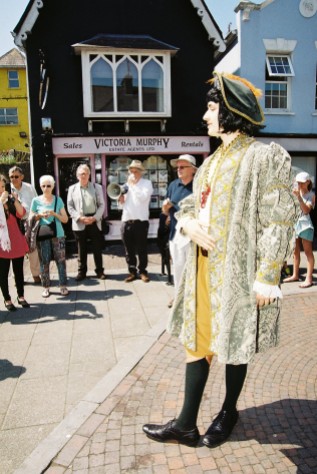

























































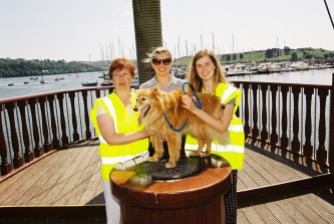




































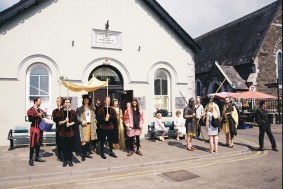













































































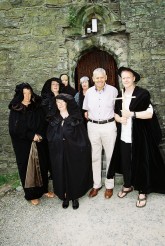


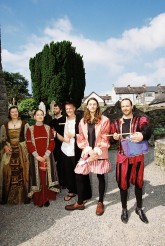















![HIRAM3[3] HIRAM3[3]](https://ireland1518dotcom.files.wordpress.com/2018/06/hiram33.jpg?w=382&resize=382%2C382&h=382#038;h=382&crop=1)

